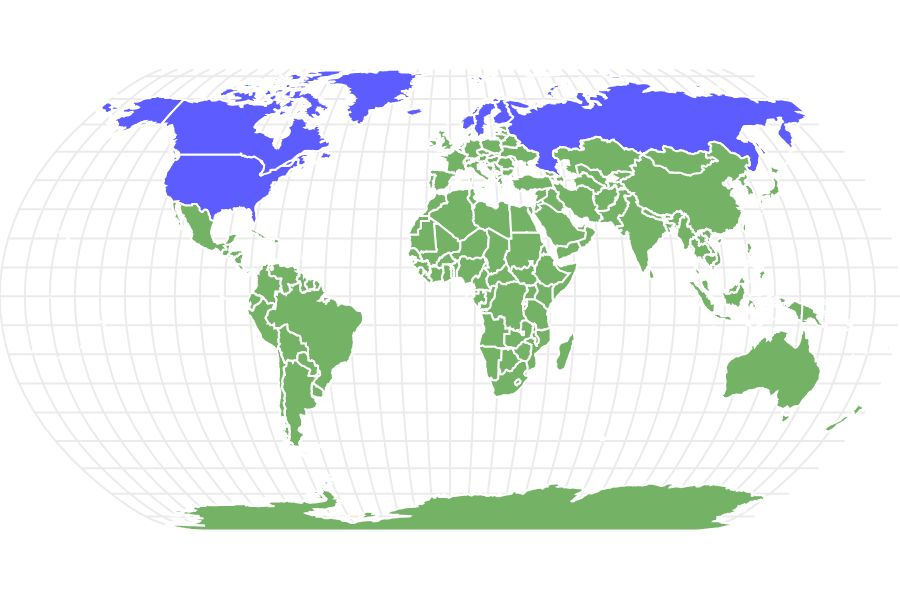Caribou
Rangifer tarandus
Males and females grow antlers
Advertisement
Caribou Scientific Classification
- Kingdom
- Animalia
- Phylum
- Chordata
- Class
- Mammalia
- Order
- Artiodactyla
- Family
- Cervidae
- Genus
- Rangifer
- Scientific Name
- Rangifer tarandus
Read our Complete Guide to Classification of Animals.
Caribou Conservation Status
Caribou Facts
- Name Of Young
- Calves
- Group Behavior
- Herd
- Fun Fact
- Males and females grow antlers
- Estimated Population Size
- About 5 million
- Biggest Threat
- Wolves, Grizzly bears, and disease
- Most Distinctive Feature
- Antlers
- Other Name(s)
- Reindeer, rangifer tarandus, qalipu, tuktu
- Gestation Period
- 228 - 234 days
- Litter Size
- 1
- Habitat
- Tundra, woodland, mountain, forest
- Predators
- Wolves, and Grizzly bears
- Diet
- Herbivore
- Favorite Food
- Reindeer Moss, grass, shrubs, leaves, mushrooms, and sedges
- Type
- Mammal
- Common Name
- Caribou or reindeer
- Number Of Species
- 9
- Location
- Canada, Alaska, Russia, Finland, Greenland, the High Arctic islands, Norway, and Iceland
Caribou Physical Characteristics
- Color
- Brown
- Grey
- White
- Dark Grey
- Skin Type
- Fur
- Top Speed
- 50 mph
- Lifespan
- 15 years
- Weight
- 180 – 701+ lbs. (depending on species)
- Height
- 33 – 59 inches (depending on species)
- Length
- 64–84 inches (depending on species)
- Age of Sexual Maturity
- 1.5 to 3.5 years
- Age of Weaning
- 5 to 6 months
View all of the Caribou images!
Caribou, which are sometimes referred to as reindeer, are notable for their antlers, growing back bigger every single year. They have unique stomach bacteria that allow them to eat many different types of food. The name caribou covers several different species, but hunting has led to the extinction of two of them.
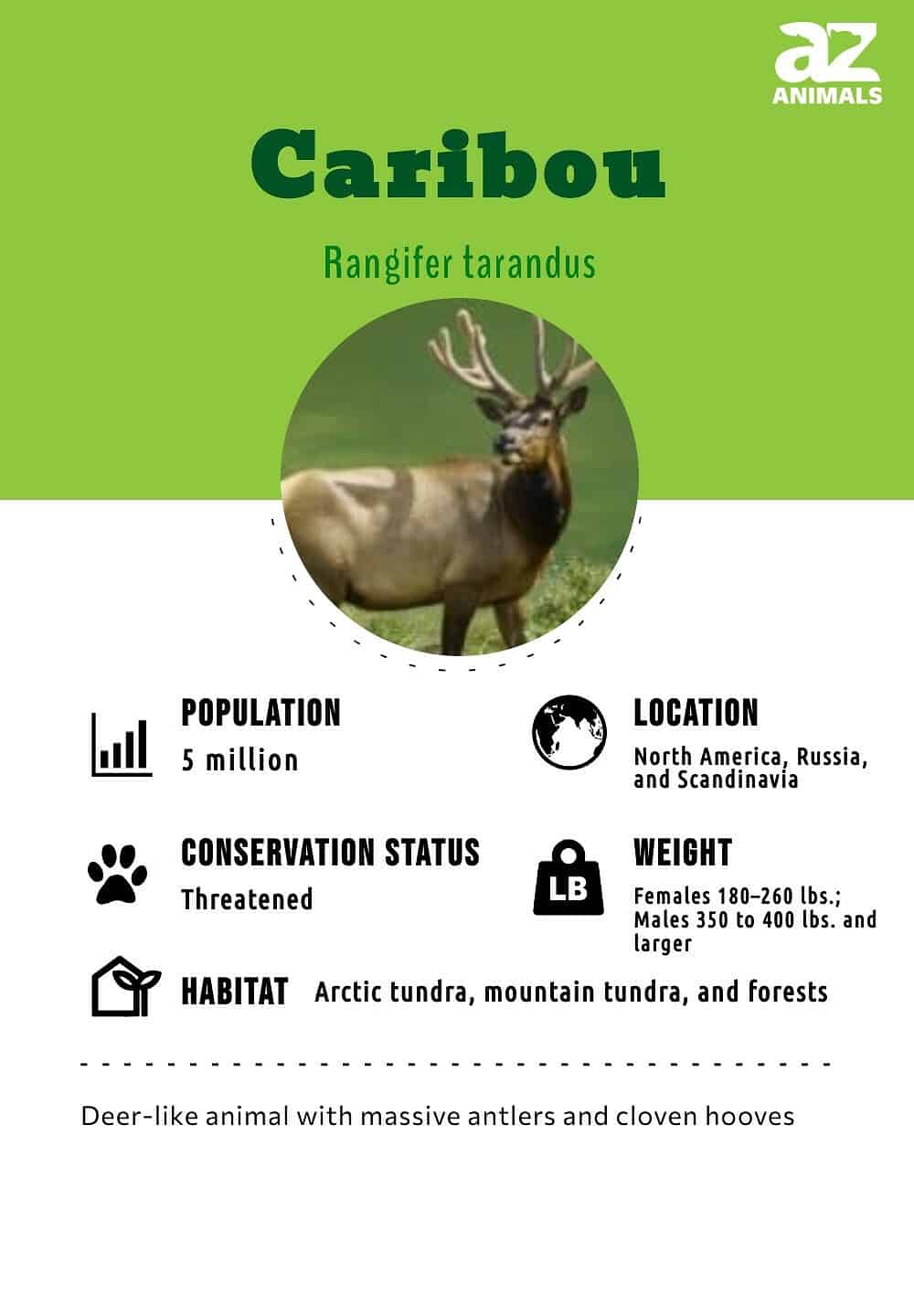
5 Incredible Facts!
Here are a few fun facts about the Caribou.
- Both males and females have antlers.
- The stomach of a caribou has four chambers.
- The color of caribou fur largely depends on where they live. Lighter colors are associated with northern regions, while caribou with dark coats live in southern areas instead.
- The scientific name of the caribou translates to “reindeer reindeer.”
- Caribou are often hunted for their meat.
You can click this link for more incredible facts about Caribou.
Scientific Name
The caribou, which goes by the scientific name “Rangifer tarandus,” is part of the Mammal class and Cervidae family. Caribou go by several names, including reindeer, qalipu, and tuktu.
The name “Rangifer tarandus” was chosen by Carl Linnaeus, describing the reindeer genus as “Rangifer.” It is Latin, and it literally means “reindeer.” Tarandus, however, comes from a New Latin translation of the ancient word “tárandos,” which means reindeer as well. This species is called reindeer only in Europe/Asia and among semi-domesticated animals in North America. Otherwise, they are caribou.
History and Species
Although the reindeer is famously associated with the Baltic and Scandinavian countries and with the Siberian and Mongolian regions, the caribou actually evolved in North America and spread to Eurasia. Fossils of caribou in Alaska and the Yukon can be dated to 1.3–1.8 million years ago.All caribou/reindeer throughout the world are considered to be the same species, but there are 7 subspecies:
- Barrenground (Rangifer tarandus granti) – the main type in Alaska, also in Canada
- Svalbard (R.t platyrhynchus),
- European (R.t. tarandus),
- Finnish forest reindeer (R.t. fennicus),
- Greenland (R.t. groenlandicus),
- Woodland (R.t. caribou) – one small herd in Alaska, also in Canada
- Peary (R.t. pearyi) – in Canada
Appearance
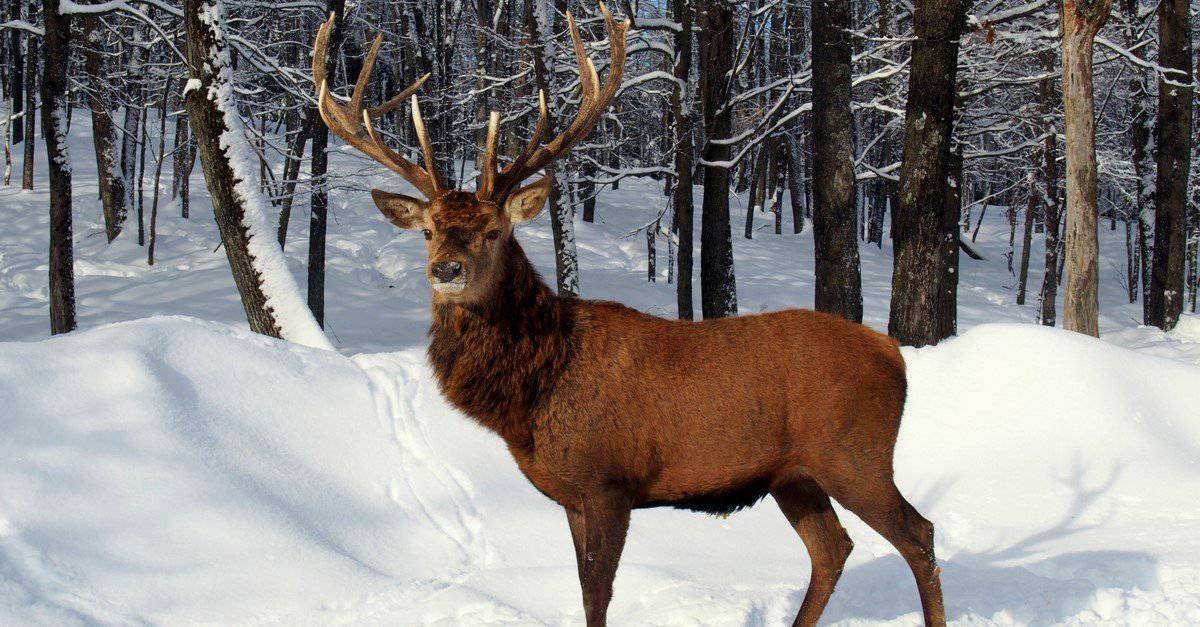
This Caribou buck has the darker colors of a woodlands dweller and the massive antlers of its species.
©Nick Couckuyt/Shutterstock.com
The caribou, better known as a reindeer, has massive antlers that start right at the brow. Both females and males have antlers, and they are the only cervid species to do so. The antlers begin to grow in March or April for males, but the females will start their growth in May and June. The antlers feature a velvety texture that is deep through to blend with the rest of their body. The rack can ultimately reach a height of 3 feet tall.
Among deer species, caribou hooves are unique. They are cloven with four toes, two of which are called dew claws, that spread widely to provide support. This structure helps the caribou to walk easily on many surfaces, including soft tundra and snow. Caribous hooves are the widest and roundest of any deer, and they actually change size according to the season. The feet also function as paddles when caribou swim, and by the way, they are excellent swimmers.
The color of the fur of this mammal largely depends on the season, the subspecies, and the individual caribou animal. In the north, the fur tends to be white to blend with the snow, which is typical of the Peary caribou. Darker fur is seen in southern areas, and the darkest caribou of all tends to be the boreal woodland caribou.
Caribou are the only deer species to have hair covering from head to toe, even covering the nose and growing under the feet to help give traction. Their fur is actually in two layers for better warmth and protection.
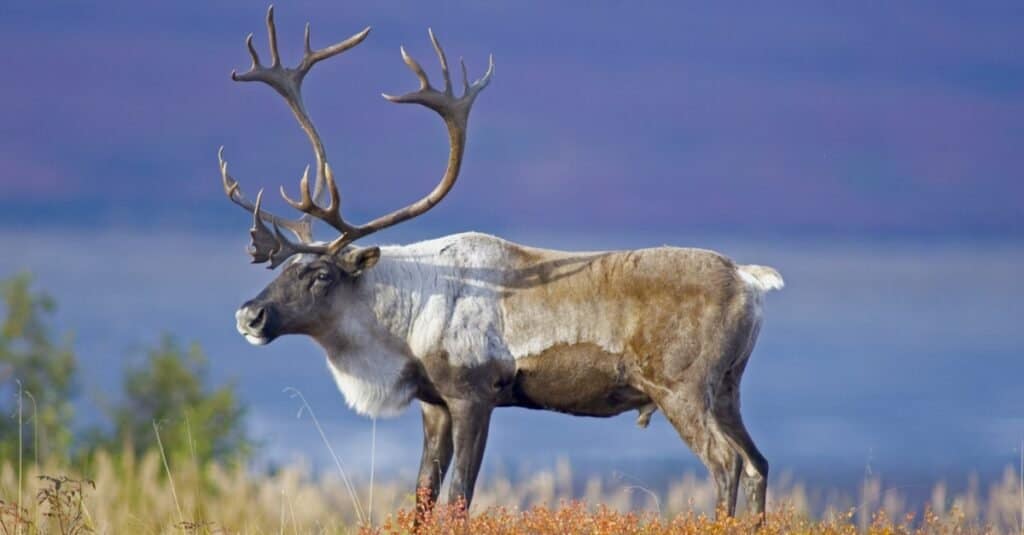
.
©Jeff McGraw/Shutterstock.com
The species will also determine how large the animal is. Females are usually smaller than males, starting at 64 inches in length, 33 inches in height, and about 180-260 lbs. in weight. The smallest reindeer comes from Svalbard and has a height of just 31 inches. Males will vary more among the species, starting at 350 lbs. However, the biggest species have males that can be well over 700 lbs. That’s slightly less than the weight of an Arabian riding horse.
Behavior
The social behavior of the Caribou largely depends on the locations and species. Reindeer occur in both migratory and sedentary populations, and their herd sizes vary greatly in different regions.
Those caribou that migrate will cover about 1,500 miles annually with impressive speed as they search for food. During migration, there’s a chance that the animal can become susceptible to parasites, making them incredibly weak. Parasites can vary from one species to the next, but migration can cause them to lose their weakest caribou during travel.
Caribou can run up to 50 mph (80 kmh). Even the baby caribou can outrun an Olympic runner when they’re barely 24-hours old. Herds that migrate during the springtime could have up to 500,000 caribou animals, though autumn migrations are much smaller.
Reindeer are the only type of deer that have been partially domesticated. Some cultures use them as work animals (like pulling a sleigh for Santa Claus!) They are, of course, an important source of food clothing, and shelter among Arctic natives .
Habitat
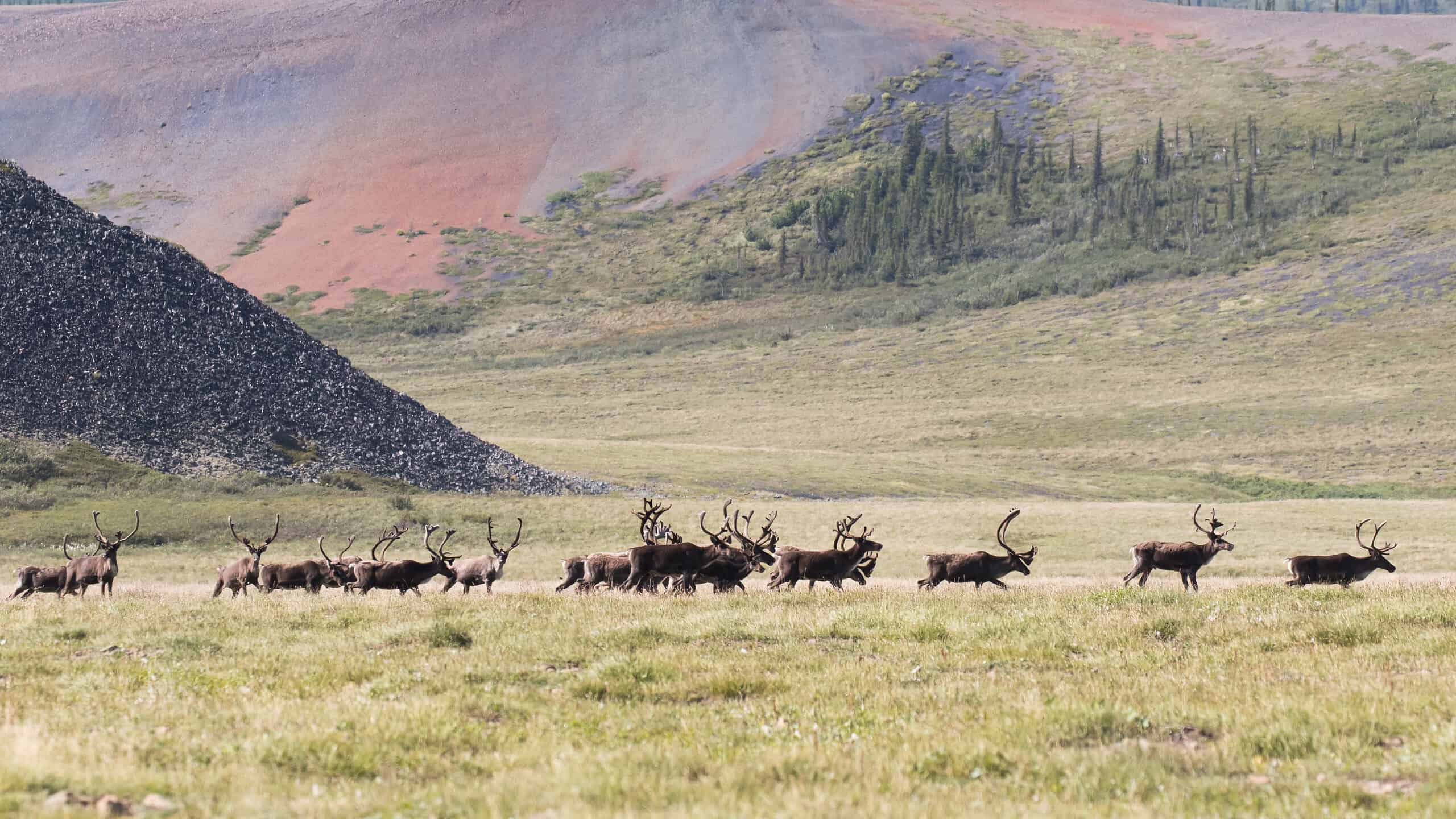
A caribou herd grazing on mountainous tundra.
©Jukka Jantunen/Shutterstock.com
Caribou previously were found only in certain locations in Scandinavia, Mongolia, Siberia, northeastern Europe, Greenland, Russia, and some parts of China. However, they can also be found in North America as low as Maine and as high as Alaska, and in most northern areas of Canada. Animals that live further north tend to have a white coat that conceals them in the snow, while southern locations feature a dark brown color that shields them in the woods.
These mammals can live in the tundra or the forest, though migration and climate change can be credited for their lower numbers across large areas.
Predators and Diet
What eats Caribou?
Although the caribou is a rather large animal, they still have many predators. In some areas, the caribou is hunted for its meat by humans. In fact, this is part of the reason that caribou disappear in some locations.
The calves are at the greatest risk of predators since golden eagles and wolverines tend to go after them. However, polar bears and brown bears will go after reindeer of all sizes. They are also extremely at risk of bloodsucking insects like mosquitoes, black flies, and the reindeer nose botfly.
What do Caribou eat?
Caribou fall under a unique category of ruminants, meaning that their stomach has a total of four chambers. They are the only large animal that can use lichen to make glucose. However, their primary diet consists of willows, birches, grasses, and other plant life. They’ll even eat the antlers of other caribou before they are shed to get supplementary nutrients. Some will even eat mushrooms.
To find plants in the snow, caribou are equipped with hooves that are hollowed out so that they can be used like scoops to dig for food.
Caribou are not really carnivorous unless they have to be. However, if their springtime nourishment isn’t quite as plentiful as they’d like, they’ll look for what’s available (like rodents, fish, and eggs).
Reproduction, Babies, and Lifespan
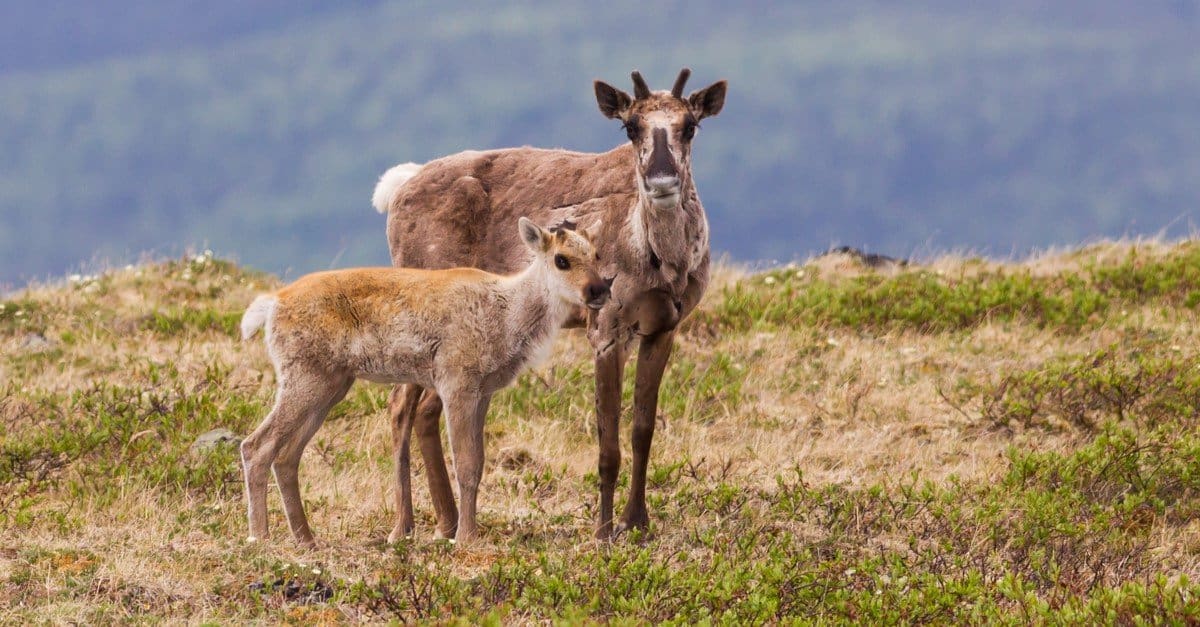
Female and calf Caribou on the alpine tundra in Yukon, Canada.
©Jukka Jantunen/Shutterstock.com
During the fall (from late September to early November), reindeers will mate. The males will battle each other to win the females, locking their antlers as they push against each other.This is called being in rut or performing ruts.
The victorious males will likely get as many as 20 females to mate with, but they will lose a lot of their weight in the process. Caribou have a gestation period of 222-234 days (about 7-8 months).
Females generally take on only one mate at this time, siding with the more dominant males. They are incredibly careful while choosing where they will give birth, looking for an area that generally doesn’t have many predators. The herd follows the doe as she looks for the right place to give birth to a single calf, which typically weighs about 13 lbs.
Babies are called calves, and they will be running in less than two hours after birth with great speed. They learn to forage as early as 45 days, although they will nurse from their mothers until the autumn when they are about 3-4 months old.
Females live longer than males, but the average lifespan of a caribou is 10-15 years.
Caribou Population
Since Caribou consist of many different species, there are a few subspecies that have already gone extinct. As recently as 2015, reindeer were on the Vulnerable list with the IUCN since they have seen a decline of 40% in the last 2.5 decades. However, the massive population of the caribou specifically ensures that the main species is not at any risk right now.
The Rangifer tarandus dawsoni already went extinct, and the Rangifer tarandus pearyi is one of the endangered species.
Caribou FAQs (Frequently Asked Questions)
What are the differences between Caribou and Moose?
Caribou and Moose are often compared to one another since they can both be found in Arctic environments. In general, moose are larger while Caribou generally have lighter coats and “thinner” horns that have a very different structure.
Are caribou carnivores, herbivores, or omnivores?
The caribou is only an herbivore, feeding on grass, shrubs, leaves, and their preferred diet of reindeer moss.
Is a caribou a reindeer?
Yes, reindeer is another name for caribou, as is rangifer tarandus, qalipu, and tuktu.
What do caribou eat?
When the season is right, reindeer moss and mushrooms are their favorite foods along with wild grasses, mosses, herbs, ferns, shrubs, and leaves.
What is a male caribou called?
Male caribou are referred to as bulls.
What are 3 facts about caribou?
Both male and female caribou have antlers. From their noses to their hooves, reindeer are covered in fur. The caribou antlers are coated in a spongy velvety layer that is shed only when fully grown.
Where does the caribou live?
Caribou live in colder remote areas of the world, such as Canada and Alaska, in forests, woodlands, and the tundra.
What animal eats Caribou?
Grizzly bears and wolves are the primary predators of caribou.
Are Caribou aggressive?
Widely domesticated, they tend to have a calm temperament and do not appear to be aggressive animals.
Can you eat caribou?
It is very desirable, both for their meat and for their milk and hides.
Which is bigger an elk or a caribou?
An adult elk can grow to a weight of 850 pounds while bull caribou can reach a maximum weight of 701 pounds and are approximately 20 inches shorter.
Thank you for reading! Have some feedback for us? Contact the AZ Animals editorial team.
Sources
- USGS, Available here: https://pubs.er.usgs.gov/publication/70048867
- Wikipedia, Available here: https://en.wikipedia.org/wiki/Reindeer
- Animal Corner, Available here: https://animalcorner.org/animals/caribou/
- Alaska Department of Fish and Game, Available here: https://www.adfg.alaska.gov/index.cfm?adfg=caribou.main
- FDA, Available here: https://www.fda.gov/animal-veterinary/animal-health-literacy/fun-facts-about-reindeer-and-caribou
- Britannica, Available here: https://www.britannica.com/animal/reindeer

